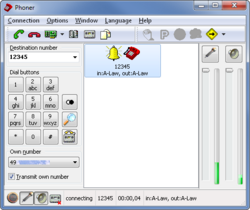Software:Phoner
 | |
 Phoner on Windows 7 | |
| Developer(s) | Heiko Sommerfeldt |
|---|---|
| Initial release | February 1998[1] |
| Stable release | 3.23
/ March 5, 2021[2] |
| Operating system | Microsoft Windows |
| Size | 4.79 MB |
| Available in | 12 languages[2] |
Expand List of languages | |
| Type | VoIP |
| License | Freeware |
| Website | phoner |
 PhonerLite on Windows 10 | |
| Initial release | 1 June 2005 |
|---|---|
| Stable release | 3.20
/ August 7, 2023[3] |
| Size | 6.70 MB |
| Available in | 10 languages[4] |
Expand List of languages | |
| Website | lite |
Phoner and PhonerLite are softphone applications for Windows operating systems available as freeware. Phoner is a multiprotocol telephony application supporting telephony via CAPI, TAPI and VoIP, while PhonerLite provides a specialized and optimized user interface for VoIP only. Beside the different user interface focus both programs share the same code base.
Both programs use the Session Initiation Protocol for VoIP call signalisation. Calls are supported via server-based infrastructure or direct IP to IP. Media streams are transmitted via the Real-time Transport Protocol which may be encrypted with the Secure Real-time Transport Protocol (SRTP) and the ZRTP security protocols. Phoner provides as well an interface for configuring and using all supplementary ISDN services provided via CAPI and thus needs an ISDN terminal adapter hardware installed in the computer.
Both programs support IPv4 and IPv6 connections by using UDP, TCP and TLS.
Supported audio formats
- G.711 A-law: 64 kbit/s payload, 8 kHz sampling rate
- G.711 μ-law: 64 kbit/s payload, 8 kHz sampling rate
- G.722: 64 kbit/s payload, 16 kHz sampling rate
- G.726: 16, 24, 32 or 40 kbit/s payload, 8 kHz sampling rate
- GSM: 13 kbit/s payload, 8 kHz sampling rate
- iLBC: 13.3 or 15.2 kbit/s payload, 8 kHz sampling rate
- Speex narrow band: 15 kbit/s payload, 8 kHz sampling rate
- Speex wide band: 30 kbit/s payload, 16 kHz sampling rate
- Opus: 10-50 kbit/s, up to 48 kHz sampling rate
- G.729: 8 kbit/s payload, 8 kHz sampling rate
- Linear PCM: 705 kbit/s payload, 44.1 kHz sampling rate
See also
References
- Hommer, Michael B. (March 2007). "Soft phone, hard benefits". Network World Canada 23 (7). https://www.proquest.com/openview/990ae3bccc5c390c512121cb582af920/1?pq-origsite=gscholar&cbl=43820.
- Zhang, Hongguang; Boutabia, Mohammed; Nguyen, Hang; Crespi, Noël; Pang, Ai-Chun; Zhou, Liang; Wei, Jianming (February 2012). "Mobile WiMAX field trial test through multimedia performance evaluation". EURASIP Journal on Wireless Communications and Networking 2012 (53). doi:10.1186/1687-1499-2012-53. https://hal.archives-ouvertes.fr/hal-00702747/file/Mobile_WiMAX_Network_Performance_v2.7_bis.pdf.
- Dove, Jackie (June 22, 2022). "The best apps for a second smartphone number". Digital Trends Media Group. https://www.digitaltrends.com/mobile/best-apps-for-a-second-phone-number/.
- Eric, Griffith (August 16, 2022). "How to Get a Secret Phone Number (and Why You Need One)". Ziff Davis. https://www.pcmag.com/how-to/burner-accounts-101-how-to-get-extra-numbers-for-a-smartphone.
External links
 |

